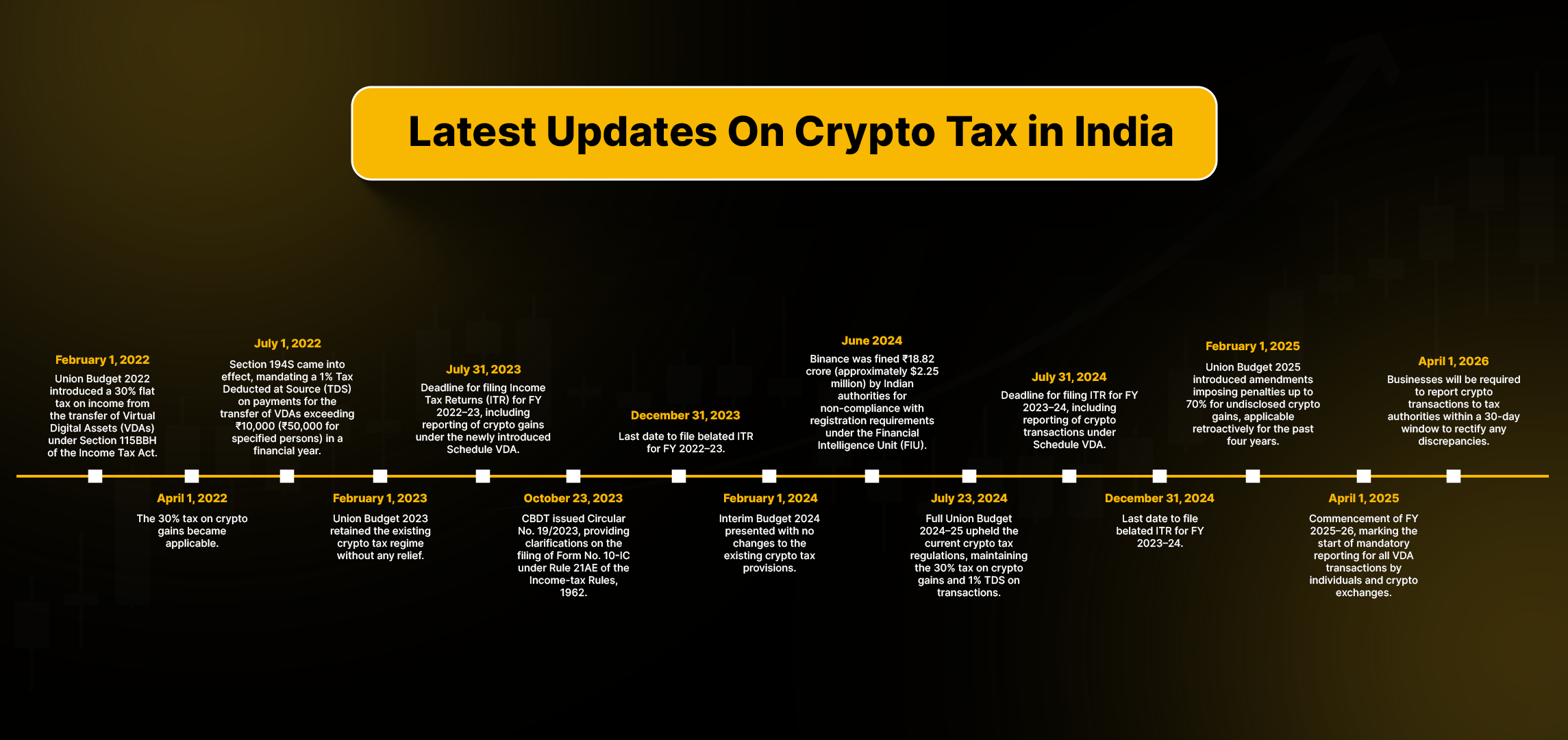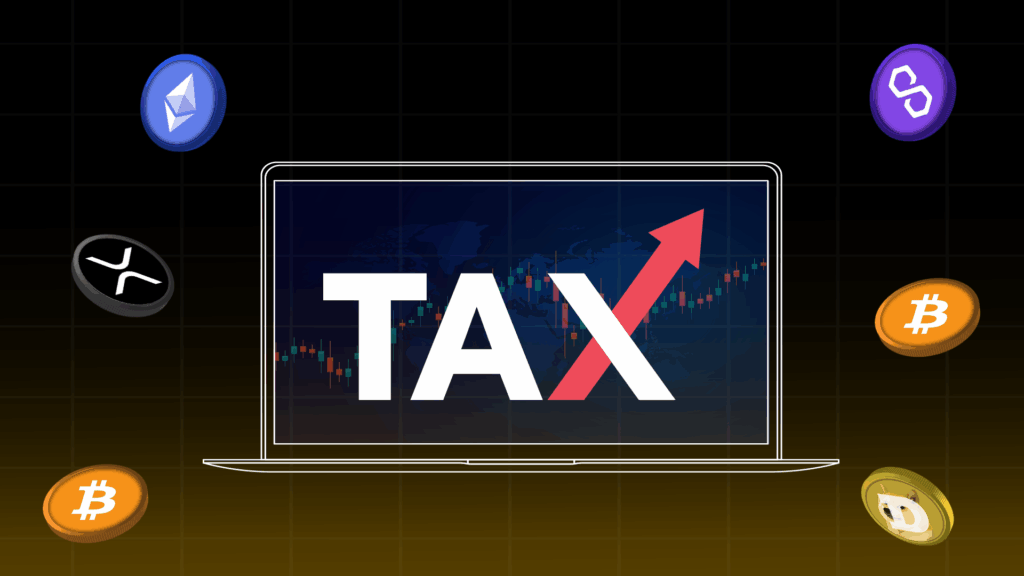As of September 2025, India has solidified its position with one of the world’s most definitive crypto tax in India regimes for Virtual Digital Assets (VDAs). With the introduction of the Schedule VDA, enhanced ITR disclosures, and strict TDS provisions, staying updated on the evolving compliance requirements is no longer optional—it’s essential for every crypto investor. This article serves as your comprehensive guide to crypto tax in India.
About Crypto Tax in India.
The journey to formalizing crypto tax in India began with the Union Budget 2022. The Hon’ble Finance Minister, Mrs. Nirmala Sitharaman, introduced revolutionary changes by officially classifying digital assets under the term “Virtual Digital Assets” (VDAs). This broad definition includes all cryptocurrencies like Bitcoin and Ethereum, as well as other digital assets such as non-fungible tokens (NFTs).
The core of India’s crypto taxation is a flat 30% tax on profits. In India, profits from selling, swapping, or spending crypto assets are taxed at a flat rate of 30%. This is further supplemented by a surcharge and an additional 4% cess, making it a critical consideration for investors and traders.
Core Insights
- Crypto Tax Implications in India: Profits earned from selling, swapping, or spending crypto assets are subject to a flat tax rate of 30%. This tax is further supplemented by applicable surcharges and an additional 4% cess, making it important for investors and traders to factor in these obligations while transacting in cryptos.
- Tax Regulations Under Section 115BBH: The taxation of crypto assets in India is governed by Section 115BBH of the Indian tax code. Under this section, there are no provisions for reduced tax rates, even for long-term capital gains. Additionally, deductions are strictly limited to the cost of acquisition of the asset. No other expenses, such as transaction fees or related costs, can be claimed as deductions while calculating taxable income.
- Tax Deducted at Source (TDS): To ensure tax compliance, a 1% Tax Deducted at Source (TDS) is levied on all transfers of VDAs. This applies to both individual and institutional transactions involving crypto assets. This measure, introduced on July 1, 2022, aims to ensure transparency in crypto transactions. The Union Budget 2025 emphasized stricter compliance and reporting obligations under this rule, especially as crypto adoption grows.
- Income Tax Return (ITR) Reporting: Starting from the fiscal year 2025-2026, mandatory reporting by crypto exchanges and other designated entities will be enforced to ensure compliance and greater tax transparency.
- G20 Stance on Crypto Regulation: Discussions among G20 nations have emphasized that banning cryptos outright would be counterproductive and impractical. Instead, they advocate for the creation of a step-by-step regulatory framework that aligns with global standards, promoting oversight while fostering innovation in the crypto ecosystem.
- Crypto Taxation in the Interim Budget 2025: The Interim Budget 2025 did not introduce any major changes to the existing crypto taxation rules in India. The prevailing regulations, including the 30% tax on profits from crypto transactions and the 1% TDS on transfers, continue to apply. However, the budget introduced additional provisions for enhanced transparency, including mandatory reporting by crypto exchanges and other entities starting in the fiscal year 2025-2026. These updates aim to ensure compliance and facilitate smoother taxation processes for the growing crypto market.
- July 2025 Crypto Tax Update: Starting July 7, 2025, an additional 18% GST is now applicable on crypto trading and service fees across platforms, covering spot, futures, and copy trading. This GST is levied over and above the existing 30% tax on crypto gains and 1% TDS per transaction, significantly raising the budgeted tax burden for Indian crypto investors. As a result, GST charges will appear as a separate line item on your transaction bills, increasing transparency but also affecting trading margins for active traders.
- August 2025: Tax Authority Crackdown: India’s tax authorities have intensified their efforts, with a significant crackdown in FY 2024-25. They uncovered a staggering $124 million in hidden crypto as part of a larger $3.3 billion recovery of undisclosed foreign assets. This included the detection of ₹1,089 crore in undisclosed foreign crypto income and ₹630 crore ($72M) in hidden Indian crypto income. This enforcement action resulted in the seizure of ₹2.7 crore in digital assets from individuals with undeclared crypto holdings, and 5,483 taxpayers filed late ITRs for the 2024–25 financial year.
- September 2025: Global Data Sharing Looms:In a major development for crypto tax in India, the nation is planning to adopt the OECD’s Crypto-Asset Reporting Framework (CARF) by April 2027. This framework will enable the automatic global data sharing on offshore wallets and exchange trades. The Finance Ministry is set to sign the Multilateral Competent Authority Agreement (MCAA) next year, extending the same system that already exposes hidden foreign bank accounts to now include digital assets. This means that investors’ overseas holdings will no longer remain invisible, with retroactive reporting possible. Tax experts are warning that compliance is now more critical than ever, especially as the ITR filing deadline has been extended to September 15th, giving crypto investors a limited window to accurately disclose and report their holdings.
Crypto Tax in India: A New Era of Enforcement
The Ministry of Finance has clarified that for the time being, no changes will be made to the existing crypto tax framework, nor are Bitcoin or crypto ETFs being considered. However, this does not mean the tax regime is stagnant. In fact, a new era of enforcement is underway, with the government leveraging technology and strategic training to ensure widespread compliance.
The focus has shifted from policy announcements to robust implementation. The government’s collection of crypto tax in India is already showing significant results, with revenues jumping from ₹269 Cr in FY 2022-23 to ₹437 Cr in FY 2023-24 (as per data from KoinX).
This increased collection is a direct result of the government’s advanced monitoring systems:
- AI-Driven Surveillance: The Income Tax (IT) Department is actively using AI-driven platforms like Project Insight and the Non-Filer Monitoring System (NMS). These tools are designed to cross-reference data on TDS (Tax Deducted at Source) filed by crypto exchanges with what individual investors report in their Income Tax Returns (ITR).
- The Crypto Tax “NUDGE”: If a discrepancy is found between your ITR and the TDS filed by an exchange, the IT department may send a “NUDGE.” This is a gentle, yet firm, reminder to review and update your tax filings. It serves as a precursor to more formal action. Discrepancies above ₹1 lakh could result in official notices or even audits, emphasizing the seriousness of non-compliance.
Future-Proofing Tax Enforcement
The government is not stopping at its current technology. It is actively preparing for even more sophisticated enforcement:
- Specialized Training: Tax officers are now undergoing intensive training in blockchain analytics, digital forensics, and crypto wallet tracing. The government has partnered with institutions like the National Forensic Science University (Goa) to upskill officials, enabling them to conduct more effective crypto-related investigations.
- Expanded Authority: From April 1, 2026, digital records, including app logs, may be used as evidence in tax investigations. Furthermore, during income tax raids, authorities are now permitted to inspect crypto wallets, giving them direct access to digital assets.
These measures highlight a clear message: the tax framework for crypto tax in India is here to stay, and the government is committed to ensuring full compliance through advanced technology and targeted enforcement. It is more important than ever for crypto investors to maintain meticulous records and file their taxes accurately.
Union Budget 2025: Crypto Tax in India
The Union Budget 2025 has introduced a significant framework for the mandatory reporting of crypto transactions, further solidifying the regulations on crypto tax in India. Starting from the financial year 2025-2026, individuals and entities dealing in Virtual Digital Assets (VDAs) must declare their crypto gains under a new section of the Indian Income Tax Act called the Schedule VDA (Section 158B). The goal of this new rule is to streamline tax reporting and enhance transparency, requiring crypto exchanges and other related platforms to submit detailed reports to tax authorities to ensure greater compliance.
A Look Back at Past Budget Updates
- Budget 2024: The Income Tax Return (ITR) for the 2023-2024 financial year was updated to include a specific section, Schedule VDA, for declaring gains from cryptocurrencies and other digital assets. The filing deadline was July 31, 2024, with a provision for filing a belated return by December 31, 2024.
- Budget 2023: The Union Budget 2022 marked a landmark moment for crypto tax in India by officially recognizing digital assets as “Virtual Digital Assets” (VDAs) rather than “currencies.” According to Section 115BBH of the Finance Bill, a taxable event is triggered by:
- Converting a digital asset to INR or another fiat currency.
- Swapping one VDA for another (crypto-to-crypto trading).
- Using a VDA to pay for goods and services.
Profits from these transactions are subjected to a flat 30% tax, equivalent to the highest income tax bracket in India. Additionally, any transaction exceeding INR 10,000 incurs a 1% TDS.
What are Virtual Digital Assets (VDAs)?
VDAs refer to any digital assets that are not physical or tangible. In simpler terms, this includes cryptocurrencies, Decentralized Finance (DeFi) tokens, and Non-fungible tokens (NFTs). The tax framework specifically targets these assets and, for now, excludes digital gold, Central Bank Digital Currency (CBDC), and other traditional digital assets.
Understanding Crypto Tax in India: A Comprehensive Guide for 2025
While discussions about crypto regulations continue, the Indian government has established a clear and non-negotiable tax framework for Virtual Digital Assets (VDAs). Based on the Union Budget 2025 and subsequent clarifications, here are the key pointers every crypto investor in India must keep in mind:
- Flat 30% Tax on Profits: Income from the transfer of VDAs, including cryptocurrencies and NFTs, is taxed at a flat rate of 30% at the end of each financial year. This rate applies irrespective of your income slab or the holding period of the asset.
- Limited Deductions: You can only deduct the cost of acquisition when calculating your taxable income from crypto. No other expenses, such as transaction fees, brokerage, or software costs, are permitted as deductions.
- No Loss Set-Off: A significant rule of crypto tax in India is that losses from one VDA cannot be set off against gains from another VDA. Furthermore, crypto losses cannot be offset against any other form of income (like salary or business income) and cannot be carried forward to future years.
- 1% TDS on Transactions: As per the rules announced in the Budget 2022, a 1% Tax Deducted at Source (TDS) is levied on every crypto transaction. This is deducted from the full sale amount, regardless of whether you are making a profit or a loss. This TDS can be claimed as a credit when you file your Income Tax Return (ITR).
Year-by-Year Update on Crypto Tax (2022–2025)

Crypto Tax Enforcement and Compliance
The government is also enhancing its enforcement mechanisms to ensure compliance:
- Mandatory Reporting (2025-2026): Starting from the fiscal year 2025-2026, mandatory reporting requirements will apply to both individuals and crypto exchanges. All crypto transactions must be reported under a dedicated section in the ITR, known as Schedule VDA.
- Higher TDS for Non-Filers: Under Section 206AB of the Income Tax Act, if a user has not filed their ITR for the last two years and their TDS is ₹50,000 or more in each of those years, the TDS on their crypto transactions will be a higher 5%.
- TDS on Prior Trades: The TDS provisions will apply even if a trade was ordered before July 1, 2022, but was executed on or after that date.
How Much Tax Will You Pay on Crypto in India?
In simple terms, you are subject to two types of crypto tax in India: a 30% tax on annual profits and a 1% TDS on every transaction.
- What is 1% TDS on crypto?
- The 1% TDS applies to all sale transactions, effective from July 1, 2022. It is deducted from the final sale amount, not just the profits, and is applicable whether you book a profit or a loss.
- How is the 30% tax calculated?
- The flat 30% income tax rate is levied on any profit made from the transfer of VDAs. This rate applies to retail investors and traders alike, with no distinction between short-term and long-term gains.
- The tax is levied on the profit (sale price minus acquisition cost). For example, if you buy crypto for ₹100,000 and sell it for ₹150,000, the ₹50,000 profit is taxed at 30%, resulting in a tax liability of ₹15,000 (plus applicable surcharge and cess).
- Do You Pay Tax When You Sell Crypto in India?
- Yes. Whether you sell crypto for Indian Rupees, US Dollars, or trade one crypto for another, any capital gain is subject to the 30% tax.
- Selling Crypto for Fiat (INR):
- 30% Tax: Any profits you make from selling crypto for INR are taxed at a flat 30%.
- 1% TDS: A 1% TDS will be automatically deducted by Indian exchanges.
Understanding Tax on Different Crypto Activities
The tax framework for crypto tax in India covers various activities:
| Crypto-to-Crypto Trading | A 30% tax is levied on any gains when you trade one crypto for another. |
| Crypto Gifts | Receiving crypto assets as a gift that exceeds ₹50,000 in value is subject to a 30% tax, unless the gift is from a specified relative. |
| Crypto Airdrops | Airdrops are generally categorized as gifts and are taxable under the 30% crypto tax if their value exceeds ₹50,000. |
| DeFi Income | Any profits from selling, swapping, or spending tokens received from DeFi activities are subject to the 30% tax. |
| HODLing & Wallet Transfer | Simply holding crypto or transferring it between your own wallets is not a taxable event. The tax is only levied upon a “transfer,” which involves a change in ownership. |
When Do You Have to Pay the 30% Crypto Tax in India?

Navigating the tax implications of cryptocurrency is essential for every investor to ensure compliance with Indian regulations. A flat 30% tax on crypto in India is applicable in the following scenarios:
- Selling Crypto for Fiat Currency: Any profits you make from selling your crypto assets in exchange for traditional currency, such as Indian Rupees (INR) or other fiat currencies, are subject to this 30% tax rate.
- Trading Crypto for Other Cryptos: If you trade one type of crypto for another, including a swap for stablecoins, any profit from the transaction is also taxed at a flat 30%.
- Spending Crypto on Goods and Services: Using your crypto assets to purchase goods or services is considered a taxable event. The gain on the transaction—the difference between the price you paid for the crypto and its value at the time of the transaction—is subject to the 30% tax.
Key Dates and Reporting Requirements
- Financial Year: In India, the financial year (FY) runs from April 1 to March 31 of the next year. For example, the current financial year is FY 2024-25 (April 1, 2024, to March 31, 2025). Your tax filing for this period will be reported during the assessment year (AY) that follows.
- Mandatory Reporting (FY 2025-26): Starting from the fiscal year 2025-2026, individuals and entities will be required to report all their crypto-related gains and activities under the newly introduced Schedule VDA section in their Income Tax Return (ITR).
Important Tax Considerations
- Crypto as Salary: While an individual’s salary is typically taxed according to the income tax slab rates (5% to 30%), any crypto received as a salary would be subject to the flat 30% tax on its value upon transfer.
- Can You Avoid the 30% Crypto Tax in India? There is no legal way to avoid paying crypto tax in India. The government has established a clear and strict regime, and non-compliance carries severe consequences based on the extent of the offense:
- Under-reporting or Misreporting Income: Penalties can range from 50% to 200% of the tax evaded, and in serious cases, can lead to imprisonment for up to 7 years.
- Late Filing of ITR: Failing to file your ITR on time can result in late fees of up to ₹5,000 and an interest charge of 1% per month on the outstanding tax amount.
- TDS Non-Compliance: Failure to deduct or deposit the mandatory 1% TDS can result in interest charges and penalties.
How to File Crypto Taxes in India?
Filing crypto taxes in India has become easier with SunCrypto. To make it an #EffortlessCryptoTax with SunCrypto, we have joined hands with KoinX to offer an embedded crypto tax calculator within the SunCrypto app. This integration automatically fetches your transaction history and computes the taxes owed based on Indian laws, including 30% tax on profits and 1% TDS. You can also generate TDS reports and ITR-compatible summaries with a few taps.
How to Stay TDS Compliant?
In the context of recent developments in India’s crypto taxation landscape, the Union Budget 2023 and the Interim Budget 2024 did not introduce any changes specifically related to Virtual Digital Assets (VDAs) following the earlier announcement of the 1% Tax Deducted at Source (TDS) on crypto. However, an important update was made through an amendment to the Income Tax Act under section 271C in the Finance Bill 2023.
According to the new amendment, failure to pay TDS will result in penalties equal to the unpaid TDS, as determined by a joint commissioner. Additionally, individuals may face a potential jail term of up to six months. In cases where there is a delay in payment, an interest rate of 15% per annum for late payment may be imposed.
To make TDS less tedious with SunCrypto, we have implemented a streamlined procedure to assist users in managing their TDS payments conveniently within the SunCrypto App. Periodically, SunCrypto will share TDS statements with its customers, ensuring they have a record of their TDS transactions and remain updated on any further developments.
To further facilitate compliance, SunCrypto takes care of paying the TDS on behalf of its users each time they conduct a transaction on the app. Consequently, users can easily access their TDS report, summary, and certificate within the app itself with just a simple click. This enables users to conveniently file their returns in the future, ensuring their tax obligations are met efficiently and effectively.
Things Investors Should Note:

Taxes on Crypto Gifts & Donations
Any gifts made in the form of virtual assets will also be taxed, and the recipient of the gift is liable to pay income tax on crypto in India at a flat rate of 30% (plus surcharge and cess). This is applicable to people gifting virtual assets such as cryptos or NFTs to friends and family in India.
Example: A received ETH worth INR 5000 from B on July 5. Since gifting falls under the income tax bracket, the INR 5000 will fall under A’s yearly income. Thus, a 30% tax on crypto will be levied.
Taxes on Crypto Airdrops
Similar to how brands will test out the feedback on new products by giving away samples to retail sellers, airdrops in the crypto space act in a similar manner. Whenever any new tokens or NFTs are launched, some of them are airdropped to investors. Since this is not a direct investment, it can be divided into two parts. Firstly, the airdropped assets will be eligible for taxes under “other incomes.” Following the airdrop event, if investors hodl the assets and gain any profit from them, that will fall under the revised 30% crypto tax.
Example: If you received 100 XYZ tokens in May 2025. The value of 1 XYZ token is INR 10. The taxable income further is INR 1000.
Specific Crypto Tax in India Categories
The framework for crypto tax in India extends beyond simple trading to cover various other activities within the digital asset ecosystem. Here’s a detailed look at how different transactions are taxed.
Taxes on Mining Cryptos
The act of mining cryptocurrency itself is not a taxable event. However, any crypto tokens you receive as a result of your mining activities are considered a form of business income and must be reported for tax purposes. This means that while you may not be taxed on the act of mining, the earnings derived from it are subject to your applicable business income tax rate.
For example, if you sell 0.25 BTC that you mined, you would owe a flat 30% tax on the profit. The cost of acquisition would be the value of the mined crypto at the time you acquired it.
Taxes on DeFi Transactions
The decentralized finance (DeFi) ecosystem involves a range of activities, including yield farming, lending, and borrowing, all of which have distinct tax implications. The taxation of these activities can be complex:
- Earning New Tokens: If you acquire new crypto tokens through DeFi activities like yield farming or staking, their value at the time of receipt is considered business income.
- Profits from Appreciation: When you eventually sell those earned tokens and they have appreciated in value, the gain is subject to the flat 30% crypto tax in India.
Taxes on Non-Fungible Tokens (NFTs)
Under the new tax laws, NFTs are explicitly categorized as Virtual Digital Assets (VDAs) and are subject to the same tax rules as cryptocurrencies.
- Tax on Profits: If you sell an NFT for a profit, the gain is taxed at a flat 30%. This is in addition to any applicable surcharge and a 4% cess.
- No Deductions: Similar to other VDAs, you cannot offset losses from an NFT sale against any other income.
- 1% TDS: A 1% TDS is levied on all NFT transfers.
Global Context and the G20 Update
India’s approach to crypto tax in India is part of a broader global conversation. During its G20 presidency, India initiated discussions on a global framework for crypto regulation, highlighting the need for international standards for this new asset class.
- Crypto-Asset Reporting Framework (CARF): The G20 countries, including India, have worked on implementing the OECD’s CARF. This framework, alongside amendments to the Common Reporting Standard (CRS), aims to enable the automatic global exchange of data on offshore crypto wallets and exchange trades. This is a significant step towards exposing undeclared foreign holdings and ensuring global tax compliance.
- No Outright Ban: The G20 discussions also made it clear that a complete ban on these assets would be counterproductive and difficult to enforce, suggesting a future focused on regulation rather than prohibition.
- Bitcoin as a Reserve Asset: In a recent development, BJP National Spokesperson Pradeep Bhandari suggested that India should consider holding Bitcoin as a reserve asset, aligning with a broader global trend of nations exploring Bitcoin’s role in macro-finance.
Conclusion
Understanding the guidelines and regulations surrounding crypto tax in India is crucial for every participant in the digital asset space. This comprehensive guide emphasizes the importance of knowing tax rates, reporting requirements, and the potential penalties for different types of crypto transactions. Adhering to the 1% TDS obligations and filing your ITR accurately and on time are essential for legal and transparent participation in the market. As the tax laws continue to evolve, staying informed and seeking expert advice will ensure you remain compliant and can navigate this new financial landscape with confidence.
Disclaimer: Crypto products and NFTs are unregulated, and there may be no legal recourse for any loss from such transactions.

